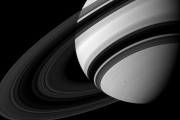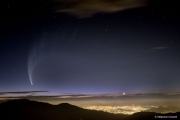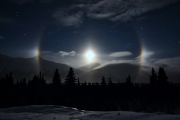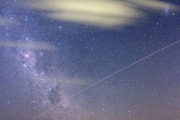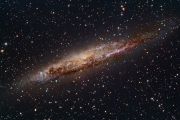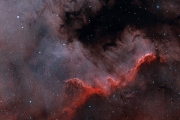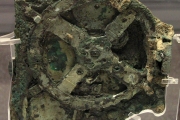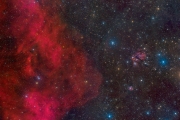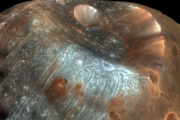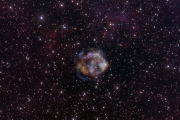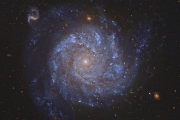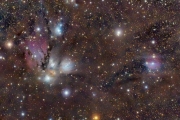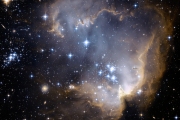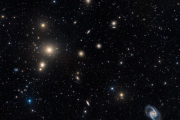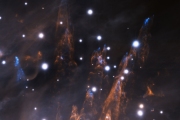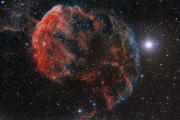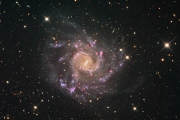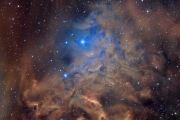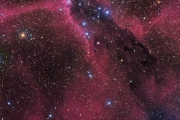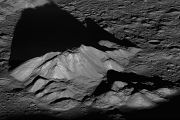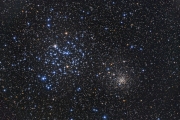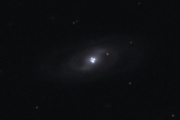|
Viewings: 28742
What are the rings of Saturn from the dark side? While on Earth, we always see the rings on the sides of the plane of the rings, with which their light, the Sun - you can call it a bright side. When this photo was taken in August by the camera in automatic spacecraft Cassini, which currently flies around Saturn, the Sun was behind the camera, but on the other hand from the plane of the rings. Such advantageous point of view allowed to make a fascinating snapshot of the most remarkable system of rings in our Solar system. Ironically, the rings look like a negative image of their front view. For example, a dark stripe in the middle is actually known to a bright ring B. If to measure the brightness of the rings when observed from different angles, you can determine the thickness of the ring and the density of particles in it. In the upper left corner of the image is visible to the satellite of Saturn, Tafia. Although it is difficult to find, it is much more massive than the whole system of rings. Clouds of glowing gas is mixed with streaks of dark dust in Tripartite nebula is a region of star formation in the constellation Sagittarius. Three huge dark lanes of dust, through which the Tripartite nebula got its name, converge at the centre. In the right part of the picture you can see the mountains opaque dust, and the rest of the nebula belted fine dust filaments. Midtown is a single massive star, which is the main cause of the illumination of Tripartite nebula. This nebula, also known as M20, is one of the youngest emission nebulae her age is just a 300 000 years. The nebula lies about 9 000 light years from us, and it is shown that stretches over 10 light years. This image is composed of several shots with different instruments: a General view of the brightness distribution is obtained, according to ground-8.2-meter telescope Subaru parts - according to a 2.4-meter Space telescope named Hubble, artificial colors are chosen by Martin Pathom, and the final picture is assembled by Robert Gangleron. Comet Maknota became one of the most photogenic comet of our time. After the comet made this representation to residents of the Northern hemisphere in early January 2007, she moved to the South, she has a giant unusual dust tail, which pleased observers in the southern hemisphere. This photograph of comet Maknota sealed over Santiago in Chile. Itself a bright comet is on the left, and its great tail stretches across the whole picture. This well located place in the Andes, it was possible to see the comet of Maknota and the beautiful sky, the Crescent moon, low clouds, atmospheric haze and the city lights. Recently, the year of 2013 promises to be even more favorable for comets than 2007. In early March the comet PANSTARRS will become visible to the naked eye. For comets ISON at the end of the year there are various options of evolution. Perhaps it will be the tail that stretches to the sky, she may break down or become one of the brightest comets in the history of mankind. Moonlight lights the snow-covered landscape on this night the picture of earth and sky, captured 17 January from the Lower Miller Creek in Alaska, USA. About mountainous Western horizon the Moon is in the phase of the first quarter. In the photo she is overexposed and surrounded by ice halos, and the right and left visible false moon. The scientific name of a false moon - paraselene. This phenomenon is analogous to the false sun, or Parghelia. It occurs when the moon light is refracted into thin flat hexagonal ice crystals in high Cirrus clouds. Paraselene visible at a distance of 22 degrees from the moon, this angle is determined by the geometry of crystals. Paraselene much weaker bright lunar disc, it is easier to notice when the Moon is low in the sky. On marine and heavenly landscape, photographed at the beginning of this month in Argentina, near to Buenos Aires, framing summer nights are clouds. However, it is not only a cloud of planet Earth. Near the arch of the milky Way above the horizon rising star clouds and nebulas, including dark Coal Bag next to the Southern Cross, and attractive rose nebula in Carina. There are also Large (top center) and the Small Magellanic cloud, a small galaxy-satellites of the milky Way located 200 000 light years from us. Only 300 light years from us shines the brightest star in the constellation Carina and the second brightest star in the sky the Earth Canopus. And at an altitude of 400 kilometers from the Earth shines by reflected sunlight international space station. This 5-minute exposition she left long luminous track. This space portrait of a huge spiral galaxy NGC 4945 is seen from the edge. The size of NGC 4945 is very similar to our milky Way. On clear color telescopic pictures visible its disk of dust, clusters of young blue stars and pink region of star formation. NGC 4945 is 13 million light-years away in the direction of the vast southern constellation of Centaurus. It is only 6 times farther away than the nearest to us spiral galaxy Andromeda. And although the Central part of the galaxy is hidden from optical telescopes, x-ray and infrared observations of the nucleus of NGC 4945 show significant highenergy radiation and intensive formation. Covered with dust, but the active core of this island universe allows you to take it to the class of Seyfert galaxies, and most likely in the very center of the galaxy lies a supermassive black hole. The North America nebula on the sky can do what can the continent of North America on Earth, she gives birth to stars. By analogy with the earth's continent, a bright part of the nebula similar to Central America and Mexico. Actually this cloud of hot gas, dust and newborn stars, known as the Wall in a Swan. This photo shows the wall being born stars lit and eaten by radiation of bright young stars. It is partially obscured by dust, which she herself had created. This part of the North America nebula (NGC 7000) stretches for 15 light years and lies about 1 500 light years away toward the constellation of Cygnus. What is it? It was found at the bottom of the sea on Board the sunken ancient Greek ship. This is obviously a complex mechanism has been studied for decades, but some of its features are still unknown. Recent studies using x-rays have confirmed the nature of Antikythera mechanism and helped to open multiple his totally unexpected features. It turned out that Antikitayskaya mechanism was an ancient mechanical computer. He made the calculations with increased accuracy for 80 years BC. Registered to this period belong the sunken ship onboard which was found device. Previously it was thought that so complex technology should appear on the Earth for at least 1000 years. These wheels and gears was a portable model of the Solar system, which could predict the positions of the planets and the moon and a solar Eclipse. Antikitayskaya mechanism is shown in the present picture, the size similar to a large book - its height is 33 centimeters. This cosmic landscape demonstrates the beauty of the world around us. Mosaic of telescopic images covers the area of about 6 degrees on the sky of the planet Earth that is 12 diameter of the full moon. The folds of red glowing gas that are visible on the left is only a small part of the huge arc of size 300 light years. Structure, known as the loop Barnard, too faint to see with the naked eye. She formed the past by supernova explosions and winds from massive stars and glows because of the emission of hydrogen atoms. Loop Barnard removed from us about 1500 light-years away, in the center there is the Great Nebula of Orion star nursery on the edge of molecular clouds in Orion. But outside are other rich star fields in the plane of our milky Way Galaxy. Right on this picture with a long exposure time can be found NGC 2170 - rich dust complex nebulae around neighboring molecular clouds at a distance of 2400 light years. The crater of sticky, the largest crater on the satellite of Mars, Phobos, is named after Chloe Angelina, sticky Hall, mathematics and the wife of astronomer Asaph Hall. Asaph Hall opened both satellites of the red planet in 1877. The size of the crater, sticky more than 9 kilometers, which is about half the diameter of the Phobos. If the strike, after which formed the crater, was a little stronger, he would have destroyed the tiny satellite. This spectacular image of sticky and its surroundings was obtained by the HiRISE camera is located on Board the Mars Orbital Scout when he flew a distance of only six thousand kilometers from Phobos in March 2008. Although the force of gravity on the surface similar to the asteroid Phobos is less than 1 / 1000th of a share of the earth, the lines suggest that loose substance over time slid inside the walls of the crater. Pale blue around the edges of the crater can be relatively recently exposed surface. The origin of the strange grooves on the surface remains mysterious, maybe it is concerned with the impact that formed the crater. Echo cosmic cataclysm - supernova remnant Cassiopeia A (Cas A) - is located at a great distance from us: more than 11 000 light years. The light from the supernova Cas A, fatal explosion of a massive star has reached the Earth only 330 years ago. Still flying cloud of stellar debris is across 15 light-years. You can see it in the very center of this composite pictures. The image is composed of a color photo in the optical range, which shows the background stars and weakly glowing gas threads, and data from orbiting x-ray telescope company nustar. Using x-ray data, painted in artificial colors, you can track the blue ring in the outer part of the cloud. This is the expanding shock wave emitting radiation, the energy of which is 10,000 times higher than the energy of optical photons. NGC 1309 - magnificent spiral galaxy distant from us 100 million light-years, is on the heavenly river - constellation of Eridan. Diameter NGC 1309 - about 30 thousand light-years, it is three times smaller than our milky Way Galaxy. Blue clusters of young stars and dust lanes outline the spiral arm NGC 1309, twisting around old yellowish stars that inhabit the core of the galaxy. NGC 1309 are not just another beautiful spiral galaxy seen flatwise. Observations recently erupted in her supernovae and variable stars - of Cepheids contribute to the calibration of the scale of distances that can better understand the expansion of the Universe. When you admire majestic spiral pattern sleeveless this beautiful galaxies, and look at many more distant background galaxies, also got on it clear perebrannoe image space telescope imhabba. On this beautiful celestial still life, written by a cosmic brush, dusty nebula NGC 2170 shines on the left from the center of the image. Next to NGC 2170, reflecting light relatives hot stars, on the background of multicolored stars are blue reflection nebulae, red emission region, and numerous dark nebula. As usual, the household items that artists often depicted on still lifes, shown here hot stars and clouds of gas and dust are often found in the environment - a massive molecular cloud in the constellation of the Unicorn, in which star formation. Huge molecular cloud Mon R2 is quite close to us, the distance is only about 2400 light years. At this distance the canvas for this picture should be of a size greater than 40 light years. On the outskirts of the Small Magellanic Cloud, remote 200 thousand light-years of the satellite of our Galaxy - is the young star cluster NGC 602, which age is 5 million years. On this gorgeous image taken by the Hubble telescope, shows that NGC 602 surrounded by gas and dust from which it was formed. Fantastic glowing strip and swept details suggest that powerful radiation and shock waves from the massive stars of NGC 602 destroy the surrounding dust clouds and cause the spreading wave of star formation, moving from the center of the cluster. In the distance the Small Magellanic Cloud is clear image covers an area of about 200 light-years, however, it can be seen, and an impressive variety of galaxy far background. These galaxies farther NGC 602 hundreds of millions of light years. How are formed and evolve cluster of galaxies? To find out, astronomers continue to explore second among the closest to the Earth galaxy clusters: cluster in the Furnace. It was called by the name of the constellation in which the majority of members of a cluster of galaxies. Although the accumulation in the Furnace almost 20 times farther than our nearest neighbor, the Andromeda galaxy, it is just 10 percent further than the more famous and containing more cluster of galaxies in Virgo. In the accumulation of the Furnace has highlighted the Central region, where many galaxies, but it continues to evolve. It contains and other marginalized groups of galaxies, which should merge in the future. Almost every yellowish spots in this image - elliptic, galactithe AC in the accumulation of the Furnace. Beautiful spiral galaxy with a jumper NGC 1365, which is visible in the lower right corner is a very prominent member of the clusters in the Furnace. In this clear and large infrared image shows how the outskirts of the Orion nebula pierce cosmic bullets flying just 1,500 light years from us. A bullet is relatively dense clouds of hot gas in size from 10 orbits of Pluto. They dumped into space by the energy born of massive stars. In artificial colors of the pictures they look blue. Shining with the light of ionized iron atoms, cosmic bullets fly with the speed of hundreds of kilometers per second, leaving a trail of yellow hydrogen, hot shock wave. Diverging from them conical wave extend over one-fifth of a light-year. This detailed image was obtained using 8.1 metre Chilean telescope of Gemini-South (Gemini South), equipped with new adaptive optics system GeMS. The system uses GeMS 5 laser artificial support of the stars to compensate turbulent effects in the Earth's atmosphere. This makes for a wide-field image than they were capable of the previous generation system. The Medusa nebula, usually so weak that it is difficult to detect, after all, was captured on this powerful telescopic image. It is near a bright star ETA Twins, at the foot of one of the heavenly twins. The jellyfish nebula is visible as a bright luminous arc centre left of the picture which goes "tentacles". Cosmic jellyfish is part shaped bubble of the supernova remnant IC 443, expanding cloud of matter ejected in the explosion of a massive star. The light from the explosion reached planet Earth more than 30 thousand years ago. IC 443 is similar to "relative" in astrophysical waters - supernova remnant Crab nebula is the fact that it is a neutron star, kolleperemetsa the core of the exploded star. The jellyfish nebula is removed from us by about 5 thousand light-years. At this distance, the image covers an area of almost $ 100 light-years. Majestic twisting spiral arm enchant considering this image of NGC 7424 - spiral galaxy with a jumper that we see flatwise. Located at a distance of 40 million light years away in the constellation of Crane, this island universe has a diameter of about 100 thousand light-years, making it remarkably similar to our milky Way. Following along twisting sleeveless, we find a lot of bright, bluish clusters of young massive stars. The diameter of these star clusters reaches a few hundred light years. And if massive stars are born in the arms of NGC 7424, and there they die. Note that in this galaxy was a powerful explosion star supernova SN 2001ig, which, however, went out to how you received this deep image. AE Area called the Blazing star. The surrounding nebula IC 405 called a nebula of Glowing stars, and it seems that it is enveloped in a sort of reddish smoke, but no fire there. Burning is usually defined as a process of rapid molecular compounds with oxygen. Burning is only when a sufficient number of free oxygen, it has nothing to so full of the energy and oxygen-poor environment, which is typical for the stars. A substance that looks like the smoke is mainly interstellar hydrogen clouds which meet like smoke dark fibers of carbon-rich dust grains. Bright star AE Area, which is visible near the center of the nebula, so hot that emitted the blue light has sufficient energy to dislodge electrons from atoms of the surrounding gas. When the proton again joins with the electron, emitted a red light, which is observed in environmental emission nebula. Shown here nebula Blazing star is at a distance of about 1500 light years. Its size is about 5 light years, and it can be seen in a small telescope in the constellation of Auriga. This cosmic dust cloud, the silhouette of which is well seen on the background filled with stars of the field in the constellation Scorpio, reminds many kind of ominous dark tower. Clots of dust and molecular gas compression which are formed stars, it can hide inside a dark nebula, which stretches about 40 light-years across this magnificent scenery of heaven. "Tip" this arrow-shaped clouds (the top of the tower, known as cometary globule, is above and to the left of the center of the picture, and all the cloud stretched until to bottom right corner. Its form is created powerful ultraviolet radiation OB-associations very hot stars of NGC 6231, which is located at the top edge of the image. UV radiation also provides energy for the reddish glow of hydrogen, bordering globule. Immersed in the hot dust of stars can be seen as small bluish reflection nebula. "The dark tower", the NGC 6231 and associated nebula are located at a distance of about 5 thousand light-years. The Central peak of the crater Tycho has cast a long, dark shadow during the sunrise at this wonderful lunar landscape. This side view was captured 10 June 2011 spacecraft "Lunar orbital scout". Impressive details rock-strewn slopes and jagged shadows visible on the high-resolution image - 1.5 meters per pixel. The rock sanctuary stretches for 15 km. It was formed when lifting rocks after the strongest impact that formed a well-known surrounded by rays crater 100 million years ago. The top of the Central peak rises to 2 km above the bottom of the crater Tycho. Scattered clusters of stars are close and distant, young and old, sparse and compact. Scattered clusters typically contain from one hundred to ten thousand stars that formed around the same time. In most young open clusters are usually present bright blue stars. Cluster M35, located on the top of the figure on the left, is a relatively close distance to it is 2800 light-years, the relatively young age of 150 million years old and quite sparse - it contains 2500 stars in volume with a diameter of 30 light-years. Older and compact scattered cluster, NGC 2158, is located on the picture below on the right. The distance to the cluster NGC 2158 4 times more than before M35, it is more than 10 times older and much more compact contains much more stars about the same amount of space. Bright blue stars in NGC 2158 have proanalizirovani and exploded. The accumulation remained mostly older and yellow star. Both clusters are located in the constellation Gemini. Most galaxies have a single nucleus -- does this galaxy four of them? Astronomers give an odd answer: this kernel galaxies in this image are not even visible. The image in the center, like a leaf clover is the light from quasars in the far background. The gravitational field of a galaxy that is visible in the foreground, focuses the light remote quasar as four separate images. In order to get such a Mirage, the quasar should be directly behind the center of a massive galaxy. This effect is called gravitational lensing, and this specific case is the Einstein Cross. It is strange that the relative brightness of the Einstein cross changing, some images may polarcat the additional effect of gravitational microlensing from individual stars in the galaxy. Few star clusters are visible so close to each other. This pair scattered, or galactic star clusters, remote from us for 7 thousand light-years, is located in the beautiful star field in the Northern constellation of Perseus. They are an excellent object for observation with binoculars, but visible to the naked eye from a dark sky. They were first brought to the directory in 130 BC by Greek astronomer Hipparchus. Currently, they are known as h and Chi Perseus, or NGC 869 (above and right) and NGC 884. The distance between the clusters is only a few hundred light years, and their constituent stars much younger and hotter our Sun. Concentrations not only physically close to each other, their age determined according to the observations of the individual stars, almost the same. Probably both clusters have formed in one area of star formation.  Com-Eva: 0 Com-Eva: 0
You are reading news Астрономическая картинка ч.20
if You liked the article Астрономическая картинка ч.20,
prokomentiruet her.
|
The world of the unknown - Onua.org
Onua.org - this site created to familiarize the user with the world of the unknown, news of technology, space discoveries and mysteries of the Earth UFO, Video , Photo, the Witnesses, the mysteries of history and ancient civilizations.
Menu
- Anomalies
- Hypothesis
- The Mysteries Of History
- Unknown
- News
- Opening
- Top secret
- Prophets
- Ancient civilizations
- Egypt
- Rome
- Greece
- Anunaki
- Nazca
- Maya
- Cosmos
- Technology
- Flora and Fauna
- Atlantis
- Bermuda triangle
- Aliens and UFOs
- Cloning
- Loch Ness
- Mysticism and Magic
- Time machine
- Parallel world
- The Tunguska meteorite
- Third Reich
- Teleportation
- Snow man
- 2012
- Nibiru
- Solar system
- The sun
- Earth
- Mars
- The rest of the planet
- Photo
- Video
- A little about everything
- Украинские аномалии
- 2013-2014 YEAR
- Questions and answers
- 100 great
Interesting
Recent VIDEOS
News calendar
Join
Popular Onua.org
Photo

The biggest fish in the world - not blue whale as one might think, because the whale belongs to a ma

Before it was invented fridge, its functions were performed in the ice, which was considered a preci
Предлагаем восстановить, заказать, купить диплом Вуза в любом городе России. Только настоящий бланк ГОЗНАК с гарантией.













